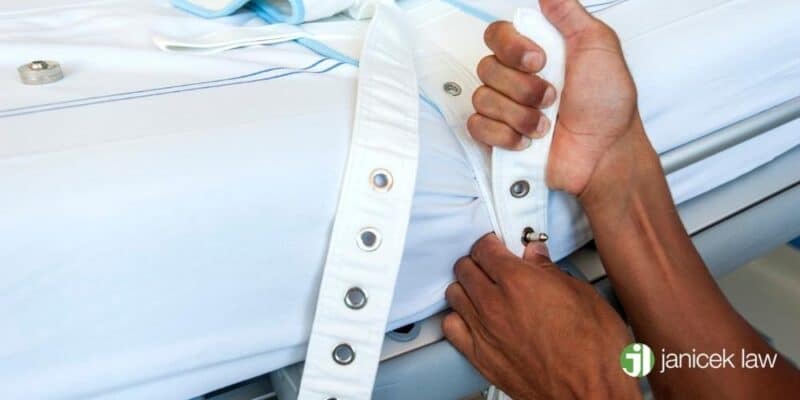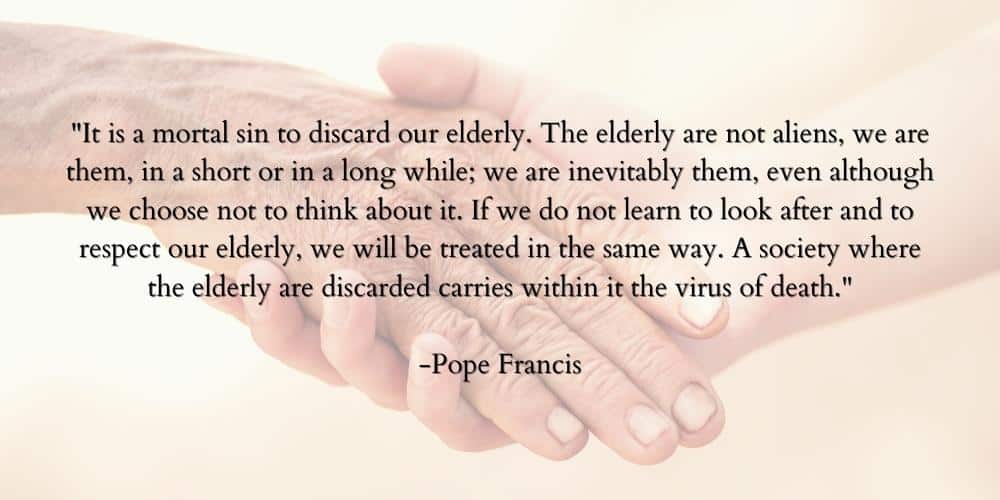San Antonio Lawyers for Restraints in Nursing Homes
San Antonio Nursing Home Restraint Lawyers
Bexar County nursing home understaffing has long been an issue. A short-term solution for an understaffed facility is to restrain residents, often unnecessarily. Unnecessary restraint is a form of nursing home abuse in Texas. If your family member has been injured due to an unnecessary physical or chemical restraint in a San Antonio nursing home, you have legal options available. At Ley de Janicek, our San Antonio nursing home restraint lawyers focus on seeking justice for those who have been abused.
Nuestro abogados con experiencia luchar agresivamente para descubrir la verdad y castigar a los abusadores. Programe una evaluación gratuita de su caso con el Abogados de abuso en hogares de ancianos de San Antonio en Janicek Law llamando 210-366-4949.
Types of Restraints in Nursing Homes in Bexar County
There are two primary types of restraints in nursing homes: physical restraints and chemical restraints.
Restricciones físicas are deliberately intended to restrict the free movement of residents. Restricciones químicas can control residents by keeping them docile. Restraints should be a last resort after all other alternative interventions fail. The use of medically necessary restraints should be re-evaluated regularly and not be in use 24/7.
Physical restraint use keeps a resident from moving their body and is often used for patients who have a higher fall risk. Chemical restraint use involves psychoactive drugs to sedate patients. Antipsychotic medications can keep patients from harming themselves or others, but these restraints are often overused to make care easier for nursing home staff.

Physical Restraints in Nursing Homes in Bexar County
Physical restraints are any type of restraint that deliberately prevents a person’s normal access to their body. This type of restraint can also restrict freedom of movement. A physical restraint can simply be a sheet or blanket tucked tightly around the resident to prevent free movement. A physical restraint can also be a mechanical device used to restrict a person’s free body movement. A physical or mechanical device can include hand mitts, bed ties, and Posey vests. Posey vests leave the patient’s arms free, but prevent their trunk from leaving their bed or chair. Chairs known as “Geri Chairs” have trays that can attach and prevent the resident from leaving the chair.
The most common types of physical restraints used in Bexar County nursing homes include:
- Vest restraints
- Wrist restraints or ankle ties
- Waist or belt restraints
- Hand mitts
- Geriatric chairs with locked trays
- Bed rails (when used to prevent exit)
- Tightly tucked sheets or positioning that restrict movement
- Wheelchairs with lap belts that cannot be unfastened independently
- Chairs angled or tilted to prevent standing
- Enclosed walkers or walker belts that limit exit
Chemical Restraints in Nursing Homes in Bexar County
Antipsychotic medications are sometimes prescribed to manage behavioral symptoms in residents with dementia, but overuse can cause serious harm, including increased risks of stroke, sedation, and death.
The rate of antipsychotic use in long-stay nursing home residents without a proper diagnosis dropped 25.8%, from 14.5% in 2015 to 10.8% in 2020, according to CMS data published in 2023. In late 2023 (latest update as of late 2025), over 1 in 5 residents were still given antipsychotics without an appropriate diagnosis. A related 2024 peer-reviewed study further confirmed that unnecessary antipsychotic use persists as a serious issue in elder care.
Antipsychotic drugs have an immobilizing effect on patients who don’t need them. Nursing homes can also use sedatives to keep patients asleep for the majority of the day–after all, a sleeping patient can’t complain. Unfortunately, these medications can cause extreme side effects for nursing home residents.
The most common types of chemical restraints in Bexar County nursing homes include:
- Antipsychotics (haloperidol, risperidone, olanzapine, quetiapine)
- Benzodiazepines (lorazepam, diazepam, alprazolam)
- Sedative-hypnotics (zolpidem, temazepam)
- Antidepressants used for sedation (trazodone, amitriptyline, mirtazapine)
- Mood stabilizers (valproic acid, carbamazepine, lithium)
- Anticonvulsants with sedating effects (gabapentin, pregabalin)
- Barbiturates (phenobarbital, secobarbital)
- Antihistamines with sedative properties (diphenhydramine, hydroxyzine)
- Centrally acting muscle relaxants (cyclobenzaprine, tizanidine)
Mechanical Restraints in Bexar County Nursing Homes
Mechanical restraints in nursing homes are devices or equipment used to restrict a resident’s movement or access to their own body, and they cannot be removed by the resident. These can include bed rails, limb restraints, lap belts, vest restraints, geri chairs with locked trays, or other mechanical devices that prevent standing, walking, or repositioning without assistance. They are typically used to prevent falls or manage behavior, but under federal and Texas law, their use is strictly regulated and often considered a last resort due to the risks of injury, loss of mobility, and violations of resident rights.
¿Por qué los hogares de ancianos usan restricciones?
Using a physical or chemical restraint gives members of staff more power over a nursing home resident. Restraints can sometimes be part of a resident’s medical treatment, but this is based on a large number of factors. The end goal has patient safety in mind. With unnecessary physical and chemical restraints, the end goal is more about the comfort of staff members. Many nursing homes are severely understaffed, but this is sin excusas restringir a los residentes en lugar de tratarlos como las personas que son.

Texas Laws on Restraints in Nursing Homes: Nursing Home Reform Act
El Ley de Reforma de Hogares de Ancianos de 1987 (también conocida como la Ley Omnibus de Reconciliación Presupuestaria o OBRA'87) fue la primera pieza de legislación que estableció expectativas legales para los centros de atención a largo plazo y su personal. Este acto se centró en los derechos de los residentes y el establecimiento de normas para su cuidado. Este acto prohíbe el uso de restricciones físicas o químicas con el propósito de disciplina o conveniencia. Los residentes de hogares de ancianos tienen derecho a recibir atención sin restricciones. Sin embargo, la ley no proscribió las restricciones por completo. Las restricciones todavía se utilizan para proteger a los pacientes de sí mismos o de dañar a otros residentes. Los pacientes que tienen un mayor riesgo de caídas suelen estar sujetados para su propia protección. Los pacientes violentos a menudo se mantienen dóciles por la seguridad física del personal del hogar de ancianos y otros residentes. Desafortunadamente, estas restricciones a menudo tienen efectos dañinos para los residentes.
Efectos nocivos del uso de restricciones en hogares de ancianos
Restricciones químicas o físicas puede tener efectos adversos en el cuerpo de una persona. Esto es especialmente cierto si tienen otras condiciones médicas como demencia o enfermedad de Alzheimer. Las restricciones conllevan un mayor riesgo de muerte, atrofia muscular, lesiones y paro cardíaco. Los fármacos antipsicóticos tienen un grave impacto en el sistema cardiovascular de los pacientes con demencia. Los hogares de ancianos continúan usando estos medicamentos para sedar a los residentes.
Lesiones Causadas por Restricciones Físicas y Químicas
Restricción física y química use can cause injuries in nursing home residents. This can include bedsores, increased falls, lower quality of life, and even death.
Úlceras por presión
Bedsores are also known as pressure ulcers. This injury is caused by prolonged pressure and is often seen in patients who have been restrained or have mobility issues. If patients are not moved regularly by staff members, these pressure wounds can develop and cause extensive damage to the skin. Stage four ulcers can even go as deep as the bone.
If your loved one developed a pressure ulcer, consult a San Antonio nursing home bed sore attorney.
Mayor riesgo de caída
Patients who spend most of their time restrained to their bed or chair can develop muscle atrophy and muscle weakness. This can cause major balance issues and increase their risk of falling when not in bed or a chair.
Contacte con un San Antonio nursing home fall lawyer para una evaluación gratuita de su caso.
Efecto sobre la salud mental
Muchos pacientes que están sujetos a restricciones físicas y químicas no pueden dar su consentimiento para la práctica. Estar atado o ser alimentado a la fuerza con medicamentos orales para la sedación puede afectar gravemente la salud mental y el bienestar del paciente. No pueden tomar decisiones por sí mismos y, a menudo, se asustan con estas medidas.
Cómo puede ayudar un abogado de negligencia y abuso en un asilo de ancianos
Healthcare professionals, including nursing home staff, have a duty to provide safe and effective medical treatment for their patients. A qualified nursing home neglect and abuse lawyer can help prove that the nursing home staff members unnecessarily used restraints on a resident and caused injuries. A nursing home will do everything in its power to hide evidence or try to offer you a settlement to keep you from going public with the abuse. In these cases, the abuse will often continue and nothing will change. You need an experienced nursing home abuse attorney to help fight aggressively for the protected rights of you and your family.
Buscando Compensación
A strong nursing home abuse case must prove the 4 D’s of negligence in Texas. Usted y su equipo legal deben probar que los miembros del personal tenían el deber de cuidar al residente, incumplieron el deber de cuidar, causaron una lesión y la lesión causó daños financieros. La compensación financiera no hará nada para cambiar lo que sucedió, pero puede responsabilizar al asilo de ancianos y a su personal por su abuso. Una demanda puede evitar que los miembros del personal traten a otros residentes de la misma manera y brindar una compensación a su familia. La compensación puede evitar que su familia acumule una montaña de deudas médicas por una lesión causada por un centro de enfermería. En Ley de Janicek, nuestros abogados luchan agresivamente por compensaciones como:
- Tratamiento médico, incluida la terapia para el trauma asociado con el abuso
- Dolor y sufrimiento
- Pérdida del disfrute en la vida.
- Angustia mental
- Y más

Contact a San Antonio Nursing Home Restraints Attorney For a Free Consultation
Janicek Law is a law firm founded on defending those unable to defend themselves. If your family member sustained injuries from the use of restraints, contact our office immediately. We can explore your legal options with a free consultation. Taking legal action can help you recover compensation for your abused family member. Legal action can also prevent negligent staff from harming other residents. Call us today at 210-366-4949 para hablar con un abogado con experiencia en negligencia en hogares de ancianos en Janicek Law.
